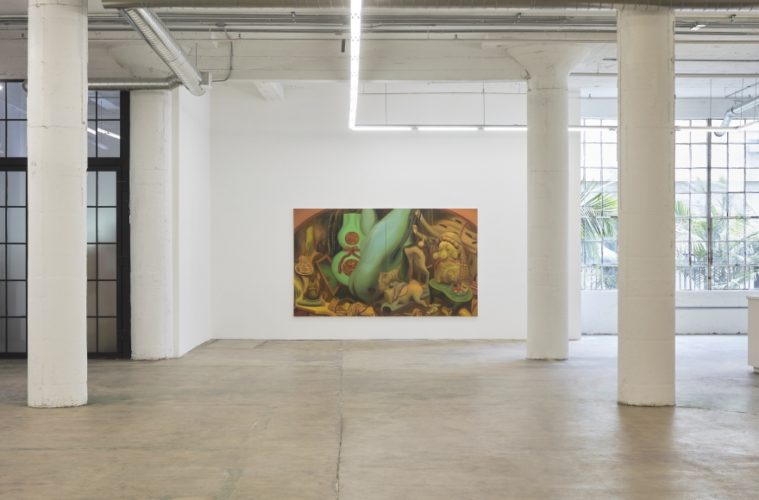With alarming pandemic numbers being reported daily, and the re-closing of gathering places both in effect and more likely imminent, the range of safe out-of-home experiences is limited — with theaters and museums in particular very much on the bubble. However, art galleries on the whole offer a satisfying compromise — with dedicated by-appointment viewing guaranteeing you’ll have these big rooms to yourself, no need for any kind of physical contact, and the providing of sanitizers and sometimes even free masks.
A few days ago, I gave it a try, visiting the galleries at the 1700 S. Santa Fe art building in downtown. The truth is that except for opening receptions, most midweek art gallery visits are always already low attendance, quiet affairs. Except for the navigation of the appointment-making (god bless those who use online schedulers!) and the extra attention paid to contact with surfaces, the experience is physically almost identical to what it has been, and spiritually even more satisfying to this fonder heart that keenly felt its absence.
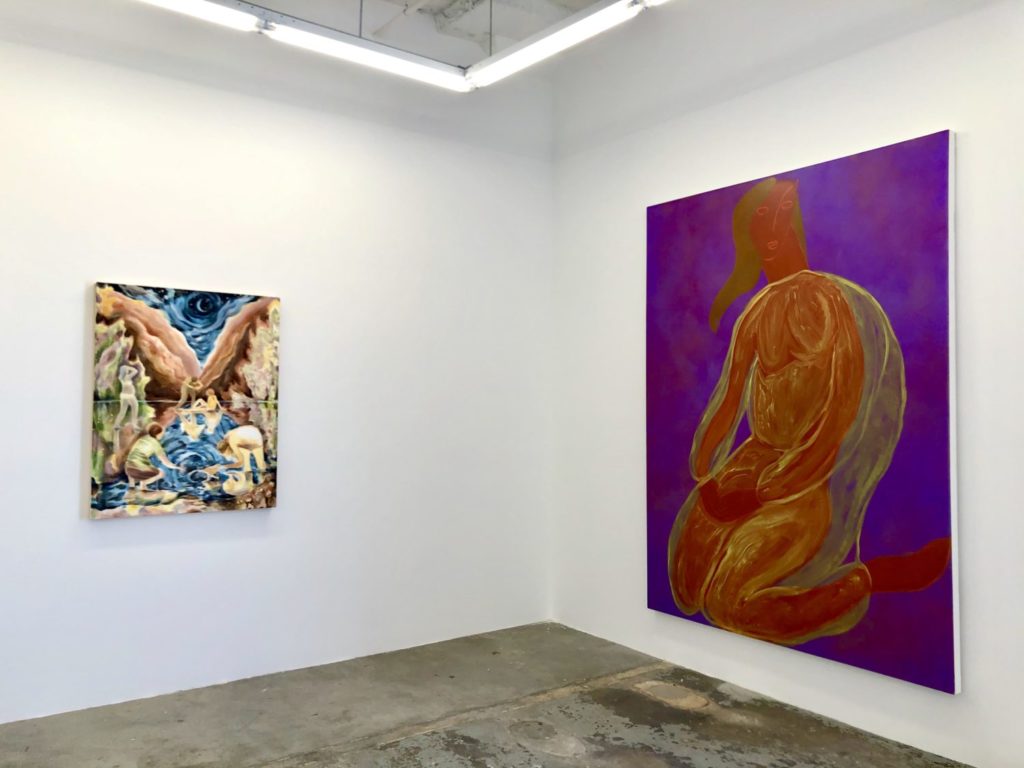
It’s a sad and beautiful world… at Wilding Cran, installation view, Michelle Blade and Vanessa Beecroft (photo by Shana Nys Dambrot)
Wilding Cran is showing It’s a sad and beautiful world…, a group show featuring largely new work by Vanessa Beecroft, Michelle Blade, Karon Davis, Katja Farin, February James and Bari Ziperstein. And since the show opened June 10, except for the Beecroft paintings, new means not only 2020, but in almost all cases, after this past March, meaning post-lockdown — and in at least one instance, even post-protests. In its selection of paintings and sculptures by women artists, each of whose work specifically addresses the depiction of the body through psychological, emotional, societal, spiritual and political lenses, the intent of the project had been to explore the psyche through the metaphorical vessel of the body. As curation proceeded, the conceptual and literal field of inquiry inevitably narrowed to meditations on the experience of distance, danger, and self-discovery.
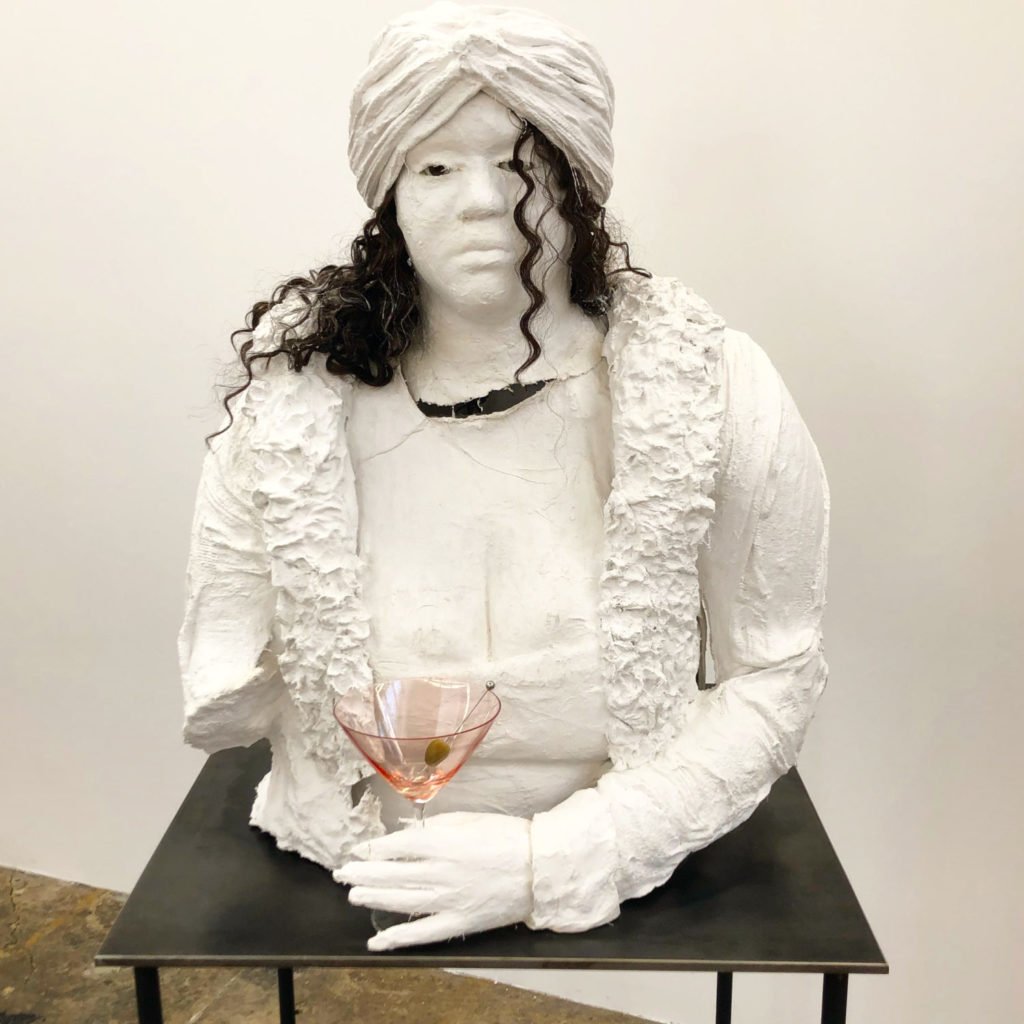
Karon Davis, Quarantini at Wilding Cran (photo by Shana Nys Dambrot)
Sculptures by Karon Davis are always directly engaged with the body, being built from sculptural foundations, castings, and intimate material details that evoke both presence and absence at the same time. Often she explores manifestations of cultural rituals, historical events, and personal biography in these celebrated works. But her contribution to this exhibition adds a new dimension — humor. Quarantini is an overture to pandemic-prompted cocktail hour despair, and a gesture of solidarity with the lonely.
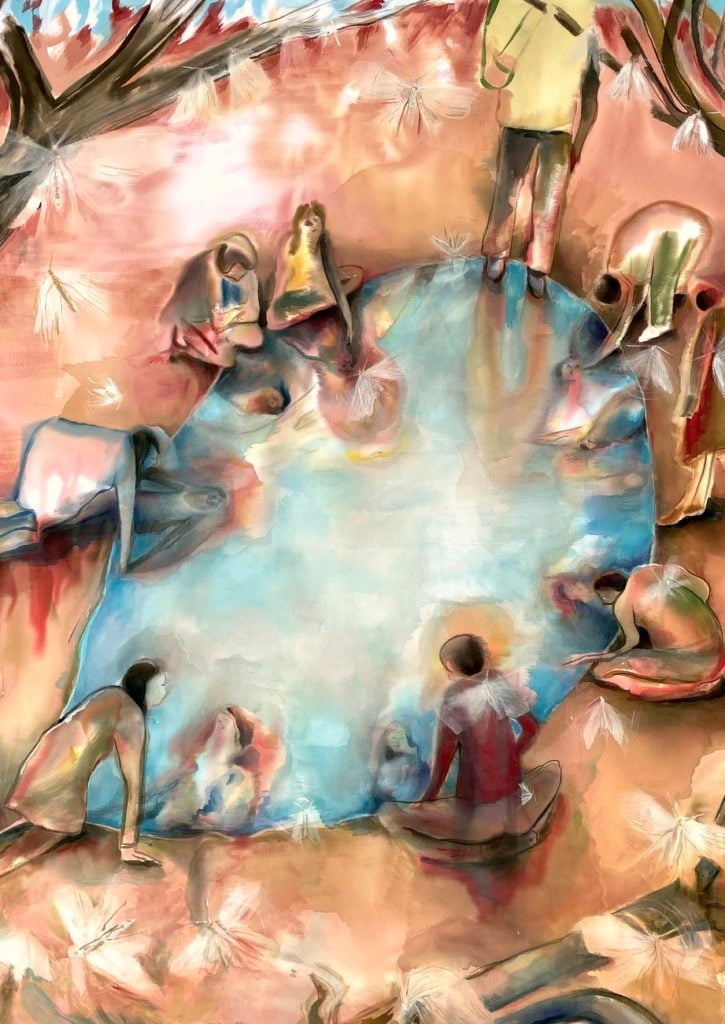
Michelle Blade, The Puddle (Wilding Cran)
Michelle Blade’s mesmeric paintings are made with acrylic ink washes, giving their overall compositions the wavering multidimensionality of saturated hues and disintegrating figures in the landscape. The Puddle in particular speaks to a poetics of the “alone together” variety in which a sort of fairytale setting is populated with single and paired figures gazing at their limpid reflections, which they do not resemble — the unsettling results of looking inward. The fractal richness in her microcosms of pigment behavior, layered details, flickering colors, and small gestures make in-person viewing not only pleasurable but especially essential.
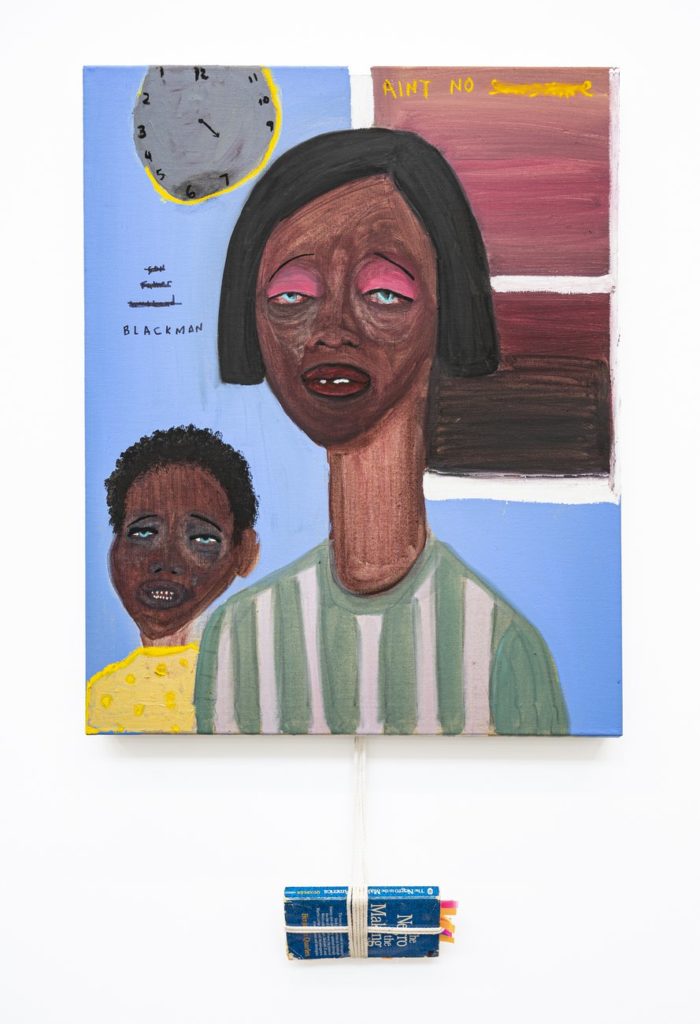
February James, On my way home (Wilding Cran)
February James in On my way home, combines oil paint, ink, liquid graphite, found book, venetian blind rope, glue, and sticky tabs into a portrait of not only a Black mother and son, but of human beings exhausted by waiting for justice and equality. Knowing this work was made in real-time response to the George Floyd protest movement, and noting that the found book is a copy of The Negro in the Making of America (1969) by Benjamin Quarles, of course add fathoms of narrative specificity to the image. But the title (a homegoing is a funeral, a Black boy simply on his way home is too often the victim of senseless police violence, home is a place of belonging and refuge…) opens the meaning of the story back up to personal experiences. It’s a sad and beautiful world… is on view through July 25; wildingcran.com.
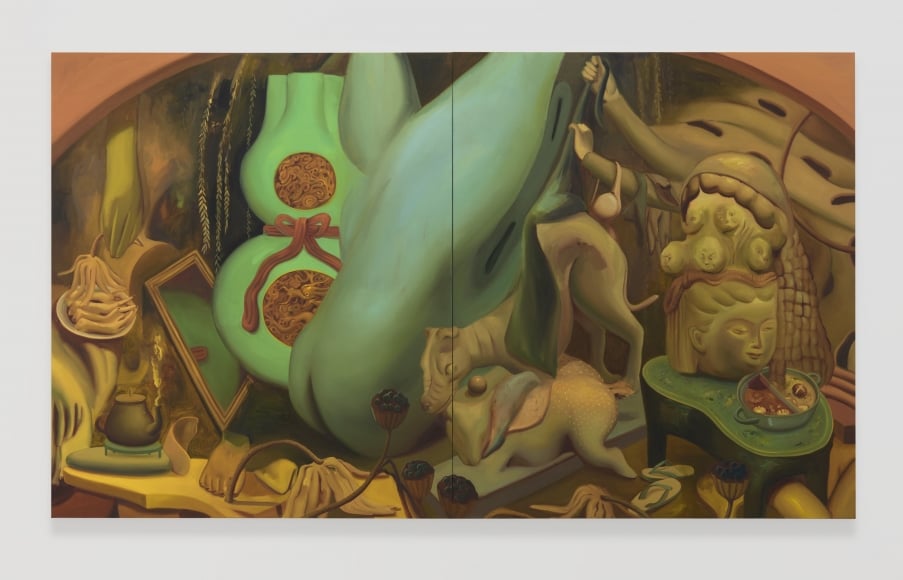
Dominique Fung, Material Manifestations in the Act of Remembrance, 2020, oil on canvas, 84 x 144 in (Nicodim)
Dominique Fung: Relics and Remains at Nicodim Gallery is an impressive series of oil paintings in which the artist addresses not only her personal Chinese heritage as a first-generation Canadian, but the way in which tradition, immigration, feminism, and art history play into that self-exploration. A seamless hybrid of Eastern and Western aesthetic citations within a completely unsettling approach to the figure, the paintings employ an eerie, eccentric palette to portray tableaux of “Orientalist” objects, stylizations of female anatomy, and references to 20th century European surrealism. It’s a dreamy and fascinating visual poetry in which everything can be understood both as itself — vase, tiger, goldfish bowl, domestic furniture, plant, wig, hands with no arms, arms with no hands — and as an analog for a facet of individual and cultural identity.
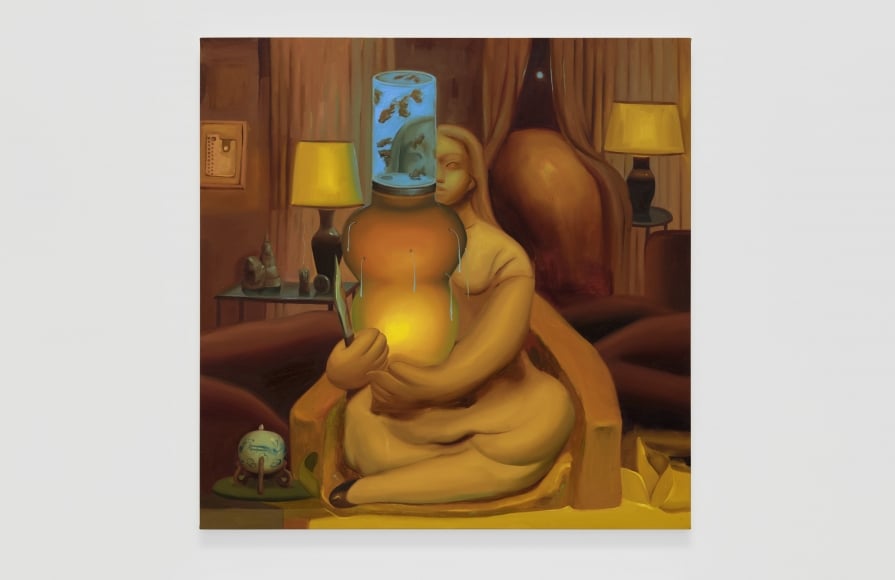
Dominique Fung, Through the Looking Glass, 2020, oil on canvas, 48 x 48 in (Nicodim)
In works like Stay Home and Through the Looking Glass, it’s hard to miss the Matisse-like foregrounding of a goldfish bowl, itself a bit of old Europe’s taste for Chinoiserie. The statuesque features of the women whose faces are refracted through the bowls, as well as their meticulous yet enigmatic surroundings have shades of both Botero and Di Chirico. The combination of gooey amber and queasy teal, which proliferates throughout the show, augments the paintings’ strangeness, as does Fung’s practice of leaving some figures and objects “incomplete” — not as in unfinished but as in missing body parts or dissolving into inscrutable abstraction.
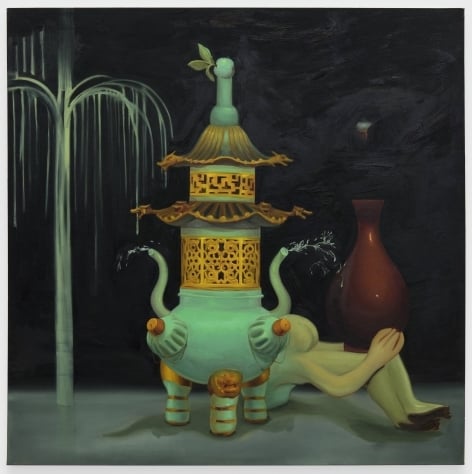
Dominique Fung, What’s Left Behind, 2020, oil on canvas, 60 x 60 inches (Nicodim Gallery)
Good Fortune Vessel (a vase in a wig), What’s Left Behind (an architecture of a footed pagoda teapot), and Material Manifestations in the Act of Remembrance (a veritable frieze of institutional looting) each features a container as an avatar for the human figure, as well as teasing out overtly Asian iconography. The surrealism of both her stylistic hat tips and the cognitive dissonances within her imagery combine in these works with a dark, slightly dusty and elusive energy which both beckons and obscures itself with a hypnotic presence. Relics and Remains is on view through July 11; nicodimgallery.com.
Advertising disclosure: We may receive compensation for some of the links in our stories. Thank you for supporting LA Weekly and our advertisers.

